Stealth technology
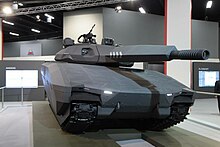
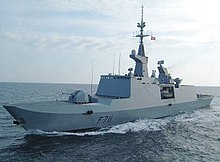
Stealth technology, also termed low observable technology (LO technology), is a sub-discipline of military tactics and passive and active
Development of modern stealth technologies in the United States began in 1958,[3][4] where earlier attempts to prevent radar tracking of its U-2 spy planes during the Cold War by the Soviet Union had been unsuccessful.[5] Designers turned to developing a specific shape for planes that tended to reduce detection by redirecting electromagnetic radiation waves from radars.[6] Radiation-absorbent material was also tested and made to reduce or block radar signals that reflect off the surfaces of aircraft. Such changes to shape and surface composition comprise stealth technology as currently used on the Northrop Grumman B-2 Spirit "Stealth Bomber".[4]
The concept of stealth is to operate or hide while giving enemy forces no indication as to the presence of friendly forces. This concept was first explored through camouflage to make an object's appearance blend into the visual background. As the potency of detection and interception technologies (radar, infrared search and tracking, surface-to-air missiles, etc.) have increased, so too has the extent to which the design and operation of military personnel and vehicles have been affected in response. Some military uniforms are treated with chemicals to reduce their infrared signature. A modern stealth vehicle is designed from the outset to have a chosen spectral signature. The degree of stealth embodied in a given design is chosen according to the projected threats of detection.
History
Camouflage to aid or avoid predation predates humanity, and hunters have been using vegetation to conceal themselves perhaps as long as people have been hunting. The earliest application of camouflage in warfare is impossible to ascertain. Methods for visual concealment in war were documented by Sun Tzu in his book The Art of War in the 5th century BC, and by Frontinus in his work Strategemata in the 1st century AD.[7]
In England, irregular units of gamekeepers in the 17th century were the first to adopt drab colours (common in 16th century Irish units) as a form of camouflage, following examples from the continent.
During World War I, the Germans experimented with the use of Cellon (Cellulose acetate), a transparent covering material, in an attempt to reduce the visibility of military aircraft. Single examples of the Fokker E.III Eindecker fighter monoplane, the Albatros C.I two-seat observation biplane, and the Linke-Hofmann R.I prototype heavy bomber were covered with Cellon. However, sunlight glinting from the material made the aircraft even more visible. Cellon was also found to degrade quickly from both sunlight and in-flight temperature changes, so the effort to make transparent aircraft ceased.[8]
In 1916, the British modified a small SS class airship for the purpose of night-time reconnaissance over German lines on the Western Front. Fitted with a silenced engine and a black gas bag, the craft was both invisible and inaudible from the ground but several night-time flights over German-held territory produced little useful intelligence and the idea was dropped.[9]
Chaff was invented in Britain and Germany early in World War II as a means to hide aircraft from radar. In effect, chaff acted upon radio waves much as a smoke screen acted upon visible light.[11]
The U-boat
In 1956 the CIA began attempts to reduce the
In 1958, the U.S.
In 1960, the USAF reduced the radar cross-section of a Ryan Q-2C Firebee drone. This was achieved through specially designed screens over the air intake, and radiation-absorbent material on the fuselage, and radar-absorbent paint.[16]
The
During the 1970s the U.S. Department of Defense launched project
Principles
Stealth technology (or LO for low observability) is not one technology. It is a set of technologies, used in combinations, that can greatly reduce the distances at which a person or vehicle can be detected; more so
, and other aspects.Radar cross-section (RCS) reductions
Almost since the invention of radar, various methods have been tried to minimize detection. Rapid development of radar during World War II led to equally rapid development of numerous counter radar measures during the period; a notable example of this was the use of chaff. Modern methods include Radar jamming and deception.
The term stealth in reference to reduced radar signature aircraft became popular during the late eighties when the Lockheed Martin
Vehicle shape
Aircraft
The possibility of designing aircraft in such a manner as to reduce their radar cross-section was recognized in the late 1930s, when the first radar tracking systems were employed, and it has been known since at least the 1960s that aircraft shape makes a significant difference in detectability. The
Another important factor is internal construction. Some stealth aircraft have skin that is radar transparent or absorbing, behind which are structures termed
The most efficient way to reflect radar waves back to the emitting radar is with orthogonal metal plates, forming a

In addition to altering the tail, stealth design must bury the engines within the wing or fuselage, or in some cases where stealth is applied to an extant aircraft, install baffles in the air intakes, so that the compressor blades are not visible to radar. A stealthy shape must be devoid of complex bumps or protrusions of any kind, meaning that weapons, fuel tanks, and other stores must not be carried externally. Any stealthy vehicle becomes un-stealthy when a door or hatch opens.
Parallel alignment of edges or even surfaces is also often used in stealth designs. The technique involves using a small number of edge orientations in the shape of the structure. For example, on the
Stealth
The shaping requirements detracted greatly from the
Similarly, coating the
) helps to reduce the aircraft's radar profile, because radar waves would normally enter the cockpit, reflect off objects (the inside of a cockpit has a complex shape, with a pilot helmet alone forming a sizeable return), and possibly return to the radar, but the conductive coating creates a controlled shape that deflects the incoming radar waves away from the radar. The coating is thin enough that it has no adverse effect on pilot vision.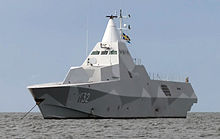
Ships
Ships have also adopted similar methods. Though the earlier
Materials
Non-metallic airframe
Radar-absorbent material
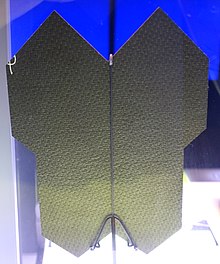
Radiation-absorbent material (RAM), often as paints, are used especially on the edges of metal surfaces. While the material and thickness of RAM coatings can vary, the way they work is the same: absorb radiated energy from a ground- or air-based radar station into the coating and convert it to heat rather than reflect it back.[36] Current technologies include dielectric composites and metal fibers containing ferrite isotopes. Ceramic composite coating is a new type of material systems which can sustain at higher temperatures with better sand erosion resistance and thermal resistance.[37] Paint comprises depositing pyramid-like colonies on the reflecting superficies with the gaps filled with ferrite-based RAM. The pyramidal structure deflects the incident radar energy in the maze of RAM. One commonly used material is called iron ball paint.[38] It contains microscopic iron spheres that resonate in tune with incoming radio waves and dissipate most of their energy as heat, leaving little to reflect back to detectors. FSS are planar periodic structures that behave like filters to electromagnetic energy. The considered frequency-selective surfaces are composed of conducting patch elements pasted on the ferrite layer. FSS are used for filtration and microwave absorption.
Radar stealth countermeasures and limits
Low-frequency radar
Shaping offers far fewer stealth advantages against low-frequency radar. If the radar wavelength is roughly twice the size of the target, a half-wave resonance effect can still generate a significant return. However, low-frequency radar is limited by lack of available frequencies (many are heavily used by other systems), by lack of accuracy of the diffraction-limited systems given their long wavelengths, and by the radar's size, making it difficult to transport. A long-wave radar may detect a target and roughly locate it, but not provide enough information to identify it, target it with weapons, or even to guide a fighter to it.[39]
Multiple emitters
Stealth aircraft attempt to minimize all radar reflections, but are specifically designed to avoid reflecting radar waves back in the direction they came from (since in most cases a radar emitter and receiver are in the same location). They are less able to minimize radar reflections in other directions. Thus, detection can be better achieved if emitters are in different locations from receivers. One emitter separate from one receiver is termed bistatic radar; one or more emitters separate from more than one receiver is termed multistatic radar. Proposals exist to use reflections from emitters such as civilian radio transmitters, including cellular telephone radio towers.[40]
Moore's law
By Moore's law the processing power behind radar systems is rising over time. This will eventually erode the ability of physical stealth to hide vehicles.[41][42]
Ship wakes and spray
Synthetic aperture sidescan radars can be used to detect the location and heading of ships from their wake patterns.[43] These are detectable from orbit.[44] When a ship moves through a seaway it throws up a cloud of spray which can be detected by radar.[45]
Acoustics
Acoustic stealth plays a primary role for
Early stealth
One method to reduce helicopter rotor noise is modulated blade spacing.[46] Standard rotor blades are evenly spaced, and produce greater noise at a given frequency and its harmonics. Using varied spacing between the blades spreads the noise or acoustic signature of the rotor over a greater range of frequencies.[47]
Visibility
The simplest technology is visual camouflage; the use of paint or other materials to color and break up the lines of a vehicle or person.
Most stealth aircraft use
In space, mirrored surfaces can be employed to reflect views of empty space toward known or suspected observers; this approach is compatible with several radar stealth schemes. Careful control of the orientation of the satellite relative to the observers is essential, and mistakes can lead to detectability enhancement rather than the desired reduction.
Infrared
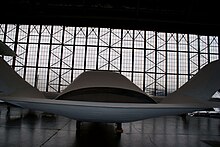
An exhaust plume contributes a significant infrared signature. One means to reduce IR signature is to have a non-circular
Ground combat includes the use of both active and passive infrared sensors. Thus, the United States Marine Corps (USMC) ground combat uniform requirements document specifies infrared reflective quality standards.[52]
Reducing radio frequency (RF) emissions
In addition to reducing infrared and acoustic emissions, a stealth vehicle must avoid radiating any other detectable energy, such as from onboard radars, communications systems, or
Measuring
The size of a target's image on radar is measured by the
If the RCS was directly related to the target's cross-sectional area, the only way to reduce it would be to make the physical profile smaller. Rather, by reflecting much of the radiation away or by absorbing it, the target achieves a smaller radar cross section.[55]
Tactics
Stealthy strike aircraft such as the
Research
After the invention of
Plasma stealth is a phenomenon proposed to use ionized gas, termed a plasma, to reduce RCS of vehicles. Interactions between electromagnetic radiation and ionized gas have been studied extensively for many purposes, including concealing vehicles from radar. Various methods might form a layer or cloud of plasma around a vehicle to deflect or absorb radar, from simpler electrostatic to radio frequency (RF) more complex laser discharges, but these may be difficult in practice.[62]
Several technology research and development efforts exist to integrate the functions of
In flexible wings, much or all of a wing surface can change shape in flight to deflect air flow.
effort.In fluidics, fluid injection into airflows is being researched for use in aircraft to control direction, in two ways: circulation control and thrust vectoring. In both, larger more complex mechanical parts are replaced by smaller, simpler, lower mass fluidic systems, in which larger forces in fluids are diverted by smaller jets or flows of fluid intermittently, to change the direction of vehicles. Mechanical control surfaces that must move cause an important part of aircraft radar cross-section.[66][67][68] Omitting mechanical control surfaces can reduce radar returns.[68][69][70] As of 2023[update], at least two countries are known to be researching fluidic control. In Britain, BAE Systems has tested two fluidically controlled unmanned aircraft, one starting in 2010 named Demon,[69][68] and another starting in 2017 named MAGMA, with the University of Manchester.[70] In the United States, the Defense Advanced Research Projects Agency (DARPA) program named Control of Revolutionary Aircraft with Novel Effectors (CRANE) seeks "... to design, build, and flight test a novel X-plane that incorporates active flow control (AFC) as a primary design consideration. ... In 2023, the aircraft received its official designation as X-65."[71][72] In winter 2024, construction began, at Boeing subsidiary Aurora Flight Sciences.[73] In summer 2025, flight testing is to start.[73]
In circulation control, near the trailing edges of wings, aircraft flight control systems are replaced by slots which emit fluid flows.[74][75][76]
List of stealth aircraft
- F-117 Nighthawk
- B-2 Spirit
- F-22 Raptor
- F-35 Lightning II
- J-20
- Su-57
- B-21 Raider[77]
- FC-31
- SU-75 Checkmate
List of reduced-signature ships
Navy ships worldwide have incorporated signature-reduction features, mostly for the purpose of reducing anti-ship missile detection range and enhancing countermeasure effectiveness rather than actual detection avoidance. Such ships include:
- Bhumibol Adulyadej-class frigate
- Independence-class littoral combat ship
- Kamorta-class corvette
- Kolkata-class destroyer
- Klewang-class fast attack craft
- Nilgiri-class frigate (2019)
- La Fayette-class frigate
- Visby-class corvette
- Skjold-class corvette
- Tuo Chiang-class Stealth Corvette
- Sachsen-class frigate
- Shivalik-class frigate
- Talwar-class frigate
- Type 055 destroyer
- Visakhapatnam-class destroyer
- Zumwalt-class destroyer
List of stealth helicopters
See also
- Active camouflage
- Multi-spectral camouflage
- Cloaking device
- Penetration aid
- Pyotr Ufimtsev – Soviet-Russian physicist who created much of the original theory behind radar stealth
References
- S2CID 108545502.
- .
- ^ a b Richelson, J.T. (10 September 2001). "Science, Technology and the CIA". The National Security Archive. The George Washington University. Retrieved 6 October 2009.
- ^ a b Merlin, Peter W. (5–8 January 2009). Design and Development of the Blackbird: Challenges and Lessons Learned (PDF). 47th AIAA Aerospace Sciences Meeting Including The New Horizons Forum and Aerospace Exposition. Orlando, Florida: American Institute of Aeronautics and Astronautics. Archived from the original (PDF) on 18 October 2013. Retrieved 6 October 2009.
- ^ Cadirci, S. "RF Stealth (or Low Observable) and Counter- RF Stealth Technologies: Implications of Counter- RF Stealth Solutions for Turkish Air Force Archived 2011-07-20 at the Wayback Machine." Naval Postgraduate School, Monterey California, PhD Thesis. March 2009. Retrieved 6 October 2009.
- ^ Yue, T. (30 November 2001). "Detection of the B-2 Stealth Bomber and a Brief History on "Stealth"". The Tech – Online Edition. Massachusetts Institute of Technology. Retrieved 5 October 2009.
- S2CID 154557121.
- ISBN 0-85177-812-7.
- ISBN 0861380738.
- ISBN 0-241-89746-7.
- ^ "U-Boat Anti Sonar Coating". Uboataces. Retrieved 18 September 2012.
- ^ Hepcke, Gerhard (2007). The Radar War, 1930–1945 (PDF) (Report). English translation by Hannah Liebmann (in German). Radar World. p. 45. Retrieved 1 February 2024.
- ^ a b Pedlow, Gregory W.; Welzenbach, Donald E. (1992). The Central Intelligence Agency and Overhead Reconnaissance: The U-2 and OXCART Programs, 1954–1974 (Report). Washington, DC: Central Intelligence Agency.
- ^ Poteat, Gene (1998). "Stealth, Countermeasures, and ELINT, 1960–1975" (PDF). Studies in Intelligence. 48 (1): 51–59.
- ^ "1960s AQM-34 Ryan Firebee (USA)". PBS. Retrieved 14 January 2015.
- ^ "YO-3A "Quiet Star" Silent Stealth Airplane". Vietnam Helicopters Museum. Retrieved 2 May 2015.
- ^ National Air Intelligence Center, Wright-Patterson AFB, OH, 1971. Technical Report AD 733203, Defense Technical Information Center of USA, Cameron Station, Alexandria, VA, 22304-6145, USA
- ^ Browne, M.W. "Two rival designers led the way to stealthy warplanes", The New York Times, Sci. Times Sec., 14 May 1991.
- ^ Browne, M.W. "Lockheed credits Soviet theory in design of F-117", Aviation Week Space Technology p. 27, December 1991.
- ^ Rich, Ben and L. Janos, Skunk Works, Little Brown, Boston, 1994.
- ISBN 1-891121-25-1. Retrieved 7 October 2009.
- ^ Kevin (14 July 2003). "F-117A Senior Trend". F-117A: The Black Jet. Retrieved 2 September 2019.
- ^ Goebel, Greg (1 March 2010). "Senior Trend". Vectorsite.net. Archived from the original on 3 January 2012. Retrieved 2 September 2019.
- ISBN 978-1-4000-5363-6.
- ^ Sweetman, Bill. "The Bomber that radar cannot see." New Scientist, 4 March 1982.
- ^ Dawson 1957, p. 3.
- ^ Seddon and Goldsmith 1999, p. 343.
- ^ Writing for the American Institute of Aeronautics and Astronautics, J. Seddon and E. L. Goldsmith noted that "Due to its all-wing shape, small vertical fin, and buried engines, at some angles [The Avro Vulcan] was nearly invisible to radar".[28]
- ^ Kingsley and Quegan 1999, p. 293.
- ^ Croddy and Wirtz 2005, pp. 341–342.
- ^ Siuru 1993, pp. 114–115.
- ^ "B-2: The Spirit of Innovation" (PDF). Northrop Grumman Corporation. Retrieved 15 October 2023.
- ^ "DDG-51 Arleigh Burke-class". FAS website. Federation of American Scientists. Archived from the original on 24 December 2013. Retrieved 2 February 2011.
- ^ Benson, Robert (November 1998). "The Arleigh Burke: Linchpin of the Navy". Asia-Pacific Defense Forum. Federation of American Scientists. Retrieved 2 February 2011.
- ISSN 2319-6483.
- ^ "How a Tougher Skin Could Change the Shape of Stealth Aircraft". 18 May 2021.
- ^ Wolchover, Natalie (21 January 2011). "How Do Stealth Planes Evade the Enemy?". Live Science. Bath, England. Retrieved 1 July 2019.
- ^ Maj. Gen. Carlsons briefing on Stealth Fighters, Tuesday, April 20, 1999
- ^ MIT's "The Tech – online edition" article Detection of the B-2 Stealth Bomber and a Brief History on "Stealth" by Tao Yue published 30 November 2001 in (Volume 121, Issue 63)
- ^ Global Opposition Movement Challenges JSF
- ^ The Naval Institute guide to world naval weapon systems By Norman Friedman, Introduction page x
- .
- .
- S2CID 32858575.
- ^ "Stealth Helicopter: MH-X Advanced Special Operations Helicopter". GlobalSecurity.org. Retrieved 28 April 2012.
- CiteSeerX 10.1.1.15.3782. Retrieved 1 July 2019.
- ^ Bush, Vannevar; Conant, James; Harrison, George (1946). "Camouflage of Sea-Search Aircraft" (PDF). Visibility Studies and Some Applications in the Field of Camouflage. Office of Scientific Research and Development, National Defence Research Committee. pp. 225–240. Archived from the original (PDF) on 23 October 2013. Retrieved 12 February 2013.
- ^ "Military Power". Aeronautics.ru. January 2000. Archived from the original on 14 January 2004.
- ^ Gosnell, Mariana (July 2007). "Flight Lines: Why contrails hang around". Air and Space. Retrieved 1 July 2019.
- ^ Kopp, Carlo (November 1989 – January 1990). "Optical Warfare – The New Frontier". Australian Aviation. 1989 (November). Australian Aviation (original). Retrieved 23 June 2019.
- ^ Junek, Larry; Cameron, Meghan; Ditto, Susan; Morris, Elizabeth; Shaughnessy, Michael (28 May 2010). "Warfighter Support: Observations on DOD's Ground Combat Uniforms; GAO-10-669R". Government Accountability Office. United States Federal Government. Retrieved 23 June 2019.
- ISBN 0-89006-618-3.
- ^ "F-22 Raptor Stealth". GlobalSecurity.
- ^ Sweetman, Bill (January 2008). "Unconventional Weapon: What we learned about stealth technology from the combat career of the F-117". Smithsonian Air & Space Magazine. Archived from the original on 19 July 2012.
- ^ Majumdar, Dave (8 November 2018). "How Russia Could Someday Shootdown an F-22, F-35 or B-2 Stealth Bomber". The National Interest.
- ^
- ^ S2CID 58670543.
- ^ S2CID 20724998.
- .
- S2CID 9321456.
- ^ Adamovich, I.V.; Rich, J. W.; Chernukho, A.P.; Zhdanok, S.A. (2000). "Analysis of the Power Budget and Stability of High-Pressure Nonequilibrium Air Plasmas" (PDF). Proceedings of 31st AIAA Plasmadynamics and Lasers Conference, 19–22 June 2000. pp. Paper 00–2418. Archived from the original (PDF) on 10 September 2006.
- ^ Scott, William B. (27 November 2006). "Morphing Wings". Aviation Week & Space Technology.
- ^ "FlexSys Inc.: Aerospace". Archived from the original on 16 June 2011. Retrieved 26 April 2011.
- ^ Kota, Sridhar; Osborn, Russell; Ervin, Gregory; Maric, Dragan; Flick, Peter; Paul, Donald. "Mission Adaptive Compliant Wing – Design, Fabrication and Flight Test" (PDF). Ann Arbor, Michigan; Dayton, Ohio; United States: FlexSys Inc., Air Force Research Laboratory. Archived from the original (PDF) on 22 March 2012. Retrieved 26 April 2011.
- ^ Uppal, Rahesh (3 March 2022). "Active Flow Control for Stealth Aircraft and Drones". International Defense, Security & Technology (IDST). Retrieved 30 May 2023.
- ^ Making aircraft less detectable (video). Europe, United States: North Atlantic Treaty Organization (NATO). 3 August 2018. Retrieved 30 May 2023.
- ^ a b c Axe, David (13 February 2019). "The F-22 and B-2 Bomber Are Old: A New Generation of Super Stealth Is Coming". The National Interest. Center for the National Interest. Retrieved 21 June 2019.
- ^ a b Christopher, Dombrowski (5 October 2010). "New test plane flies without control surfaces". Ars Technica. Wired Media Group. Retrieved 21 June 2019.
- ^ a b "Successful first flight trial completion of unmanned aerial vehicle, MAGMA". BAE Systems. 13 December 2017. Retrieved 21 June 2019.
- ^ Wlezien, Richard. "Control of Revolutionary Aircraft with Novel Effectors (CRANE)". Defense Advanced Research Projects Agency (DARPA). Retrieved 4 October 2023.
- ^ Trimble, Steve (16 May 2023). "DARPA Receives X-65 Designation for Active Flow Experiment". Aviation Week & Space Technology. Retrieved 4 October 2023.
- ^ a b Smith, Carmen (3 January 2024). "Aurora Begins Building Full-Scale Active Flow Control X-Plane". Aurora Flight Sciences, Boeing (Press release). Retrieved 1 February 2024.
- S2CID 56205932. Archived from the originalon 23 June 2018.
- ^ "Showcase UAV Demonstrates Flapless Flight". BAE Systems. 2010. Archived from the original on 7 July 2011. Retrieved 22 December 2010.
- ^ "Demon UAV jets into history by flying without flaps". Metro. UK: Associated Newspapers Limited. 28 September 2010.
- ^ "New stealth bomber contract likely to be boon for Antelope Valley". Los Angeles Times. 8 February 2015. Retrieved 17 March 2023.
Bibliography
- Dawson, T.W.G., G.F. Kitchen and G.B. Glider. Measurements of the Radar Echoing Area of the Vulcan by the Optical Simulation Method. Farnborough, Hants, UK: Royal Aircraft Establishment, September 1957 National Archive Catalogue file, AVIA 6/20895
- Ufimtsev, Pyotr Ya., "Method of edge waves in the physical theory of diffraction," Moscow, Russia: Izd-vo. Sov. Radio [Soviet Radio Publishing], 1962, pages 1–243.
- Doucet, Arnaud; Freitas, Nando de; Gordon, Neil (2001) [2001]. Sequential Monte Carlo Methods in Practice. Statistics for Engineering and Information Science (1st ed.). Berlin: Springer-Verlag. ISBN 978-0-387-95146-1. Retrieved 11 March 2009.
- Analogues of Stealth – Northrop Grumman Archived 12 August 2012 at the Wayback Machine
- Countering stealth
- How "stealth" is achieved on F-117A
- United States Patent No.6,297,762. 2 October 2001. Electronic countermeasures system (Apparatus for detecting the difference in phase between received signals at two spaced antennas and for then retransmitting equal amplitude antiphase signals from the two spaced antennas is disclosed.)
- Gal-Or, Benjamin (1990). "Multiaxis Thrust Vectoring Flight Control vs Catastrophic Failure Prevention". Vectored Propulsion, Supermanoeuvreability, and Robot Aircraft. Reports to U.S. Dept. of Transportation/FAA, Technical Center, ACD-210, FAA X88/0/6FA/921000/4104/T1706D, FAA Res. Grant-Award No: 94-G-24, CFDA, No. 20.108, 26 December 1994. Springer Verlag. ISBN 0-387-97161-0. and 3-540-97161-0.
- Suhler, Paul A. (2009). From Rainbow to Gusto: Stealth and the Design of the Lockheed Blackbird. American Institute of Aeronautics and Astronautics. ISBN 978-1-60086-712-5.
